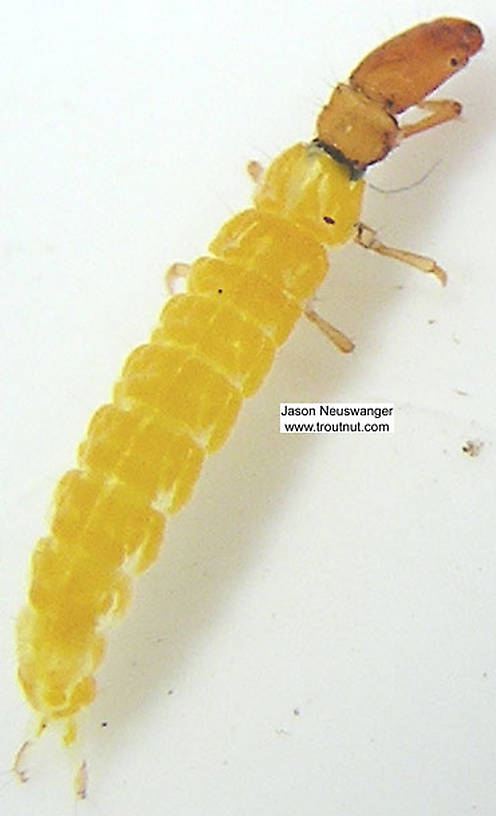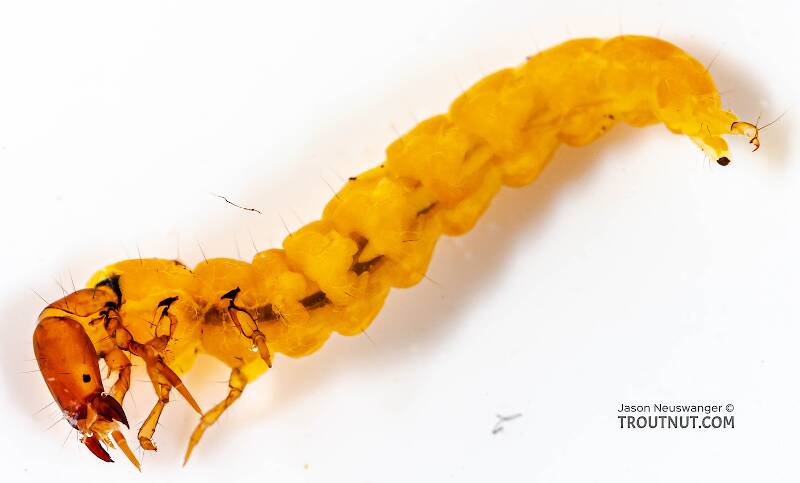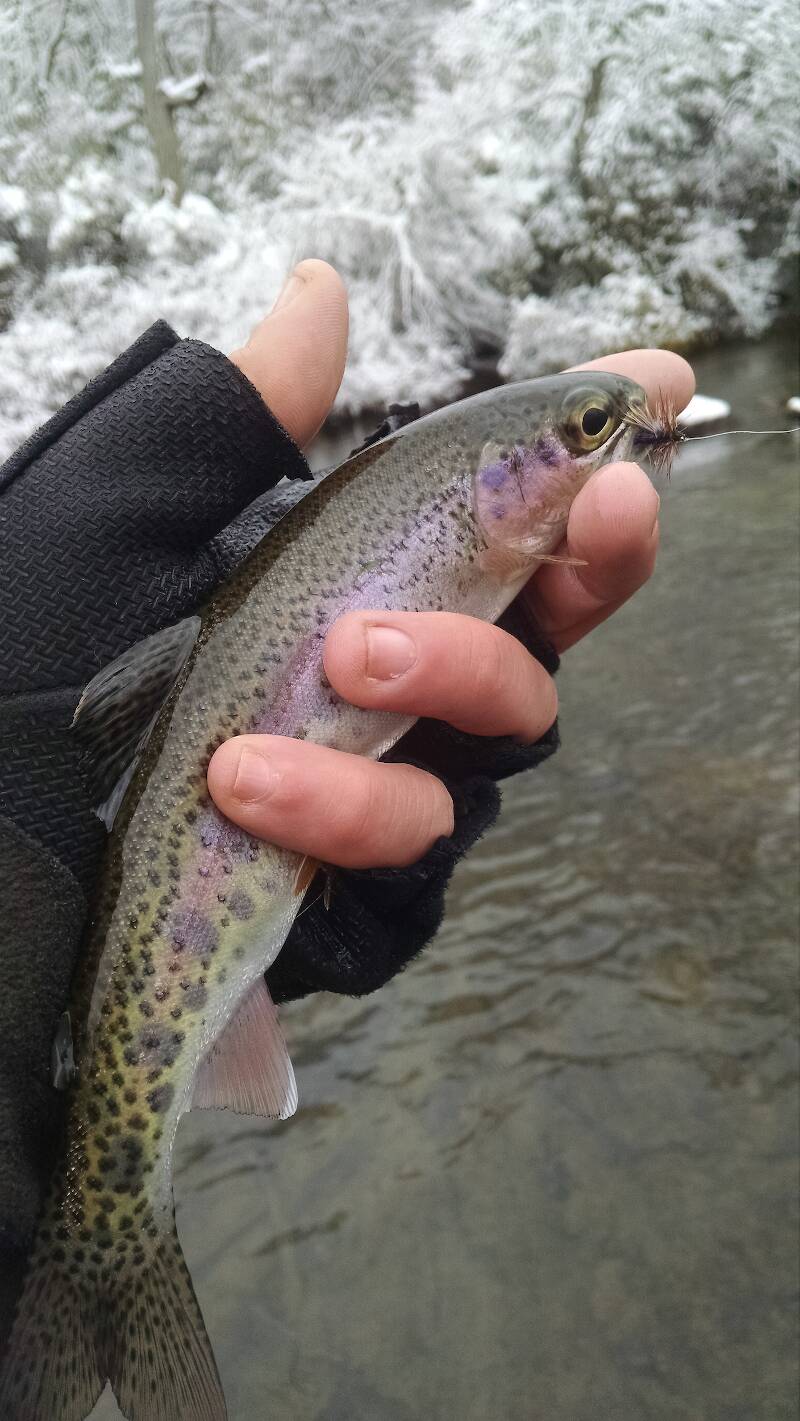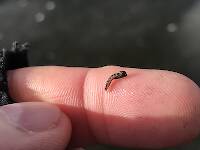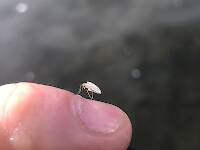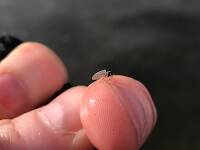
Blue-winged Olives
Baetis
Tiny Baetis mayflies are perhaps the most commonly encountered and imitated by anglers on all American trout streams due to their great abundance, widespread distribution, and trout-friendly emergence habits.
Featured on the forum

This one seems to lead to Couplet 35 of the Key to Genera of Perlodidae Nymphs and the genus Isoperla, but I'm skeptical that's correct based on the general look. I need to get it under the microscope to review several choices in the key, and it'll probably end up a different Perlodidae.

Troutnut is a project started in 2003 by salmonid ecologist Jason "Troutnut" Neuswanger to help anglers and
fly tyers unabashedly embrace the entomological side of the sport. Learn more about Troutnut or
support the project for an enhanced experience here.
This topic is about the Caddisfly Genus Chimarra
Chimarra aterrima is the most important species.Example specimens
Btopbuckeye on Mar 4, 2015March 4th, 2015, 3:57 pm EST
I had a large swarm of black sedges in a size 16 ovipositing today.the females hadvblack wings and body with a green egg sack was just wondering if that is this genus or something totally different
Entoman on Mar 5, 2015March 5th, 2015, 7:29 am EST
Welcome to the forum. They are most likely Brachycentrus (Grannoms).
"It's not that I find fishing so important, it's just that I find all other endeavors of Man equally unimportant... And not nearly as much fun!" Robert Traver, Anatomy of a Fisherman
Gutcutter on Mar 5, 2015March 5th, 2015, 7:50 am EST
Are you sure they were caddis and not stoneflies?
The larger "little black stones" (around a size 16) start to flutter around this time of year up here.
The egg sacks I see are yellowish on the stones.
I'm not sure of the timing of Grannoms or stones in N.C.
The larger "little black stones" (around a size 16) start to flutter around this time of year up here.
The egg sacks I see are yellowish on the stones.
I'm not sure of the timing of Grannoms or stones in N.C.
All men who fish may in turn be divided into two parts: those who fish for trout and those who don't. Trout fishermen are a race apart: they are a dedicated crew- indolent, improvident, and quietly mad.
-Robert Traver, Trout Madness
-Robert Traver, Trout Madness
Crepuscular on Mar 5, 2015March 5th, 2015, 9:10 am EST
Welcome to the forum. They are most likely Brachycentrus (Grannoms).
I was going to say the same Kurt but the description of the Black Wings had me wondering, really Btopbuckeye, It's virtually impossible to say with any kind of certainty what they may have been. But as Kurt pointed out they may have been Brachycentrus sp., the green eggs would be consistent with that. And I imagine you are a head of us here in PA with timing of hatches and we usually see Brachycentrus (Grannoms) in mid to late April here in southern PA. I've heard those Rainbows in the Nantahalla are beautiful fish! I'd like to see one up close and personal some day.
Martinlf on Mar 5, 2015March 5th, 2015, 11:56 am EST
Given that the egg sacks were green, it would seem they were caddis of some sort. At least one hatch chart for the Smokies lists "Grannoms" this early:
http://www.perfectflystore.com/hcsmokymtns.html
And they provide specific information about the bug, which they call a "little black caddis":
http://www.perfectflystore.com/littleblcadisinfo.html
They identify the Grannom that hatches early in the Smokies as Brachycentrus occidentalis.
In regard to our Grannoms here in PA, one of Troutnut's bug experts, Lloyd Gonzales observes: "The collecting record shows two Brachycentrus spp. for Huntingdon County [PA]--B. numerosus and solomoni"; and he identifies numerosus as the species most commonly found on Penns Creek.
Eric, might the possible species difference at least partially explain the difference in hatch time, along with geographical differences?
Brian, The Nantahala is certainly a beautiful river; along with the Ocoee it was a favorite when I was a whitewater guide in North Carolina. We primarily frequented the lower reaches, taking out just after the first falls above the Nantahala Outdoor Center. I once saw a kid walking along one of the feeder streams to the Nantahala carrying a stringer of big rainbows. Obviously not a proponent of catch and release.
http://www.perfectflystore.com/hcsmokymtns.html
And they provide specific information about the bug, which they call a "little black caddis":
http://www.perfectflystore.com/littleblcadisinfo.html
They identify the Grannom that hatches early in the Smokies as Brachycentrus occidentalis.
In regard to our Grannoms here in PA, one of Troutnut's bug experts, Lloyd Gonzales observes: "The collecting record shows two Brachycentrus spp. for Huntingdon County [PA]--B. numerosus and solomoni"; and he identifies numerosus as the species most commonly found on Penns Creek.
Eric, might the possible species difference at least partially explain the difference in hatch time, along with geographical differences?
Brian, The Nantahala is certainly a beautiful river; along with the Ocoee it was a favorite when I was a whitewater guide in North Carolina. We primarily frequented the lower reaches, taking out just after the first falls above the Nantahala Outdoor Center. I once saw a kid walking along one of the feeder streams to the Nantahala carrying a stringer of big rainbows. Obviously not a proponent of catch and release.
"He spread them a yard and a half. 'And every one that got away is this big.'"
--Fred Chappell
--Fred Chappell
Oldredbarn on Mar 5, 2015March 5th, 2015, 1:50 pm EST
Welcome to the forum. They are most likely Brachycentrus (Grannoms).
Kurt...Every darn hatch chart in this state still has the "Little Black Caddis" listed as Chimarra! And listed as an 16/18 hook!? Even after Carl Richards, no less, told them about, B lateralis, B numerosus, and B americanus...
I have made loud, Molson infused, bets to some folk here that they probably haven't ever seen a Chimarra.
Spence
"Even when my best efforts fail it's a satisfying challenge, and that, after all, is the essence of fly fishing." -Chauncy Lively
"Envy not the man who lives beside the river, but the man the river flows through." Joseph T Heywood
"Envy not the man who lives beside the river, but the man the river flows through." Joseph T Heywood
Crepuscular on Mar 6, 2015March 6th, 2015, 3:41 am EST
Eric, might the possible species difference at least partially explain the difference in hatch time, along with geographical differences?
yes
Quick Reply
Related Discussions
Topic
Replies
Last Reply
0
Mar 23, 2010
by Troutboomer
by Troutboomer
0
May 6, 2011
by Jtberez
by Jtberez
9
Apr 30, 2013
by Oldredbarn
by Oldredbarn


